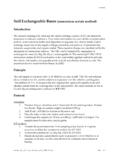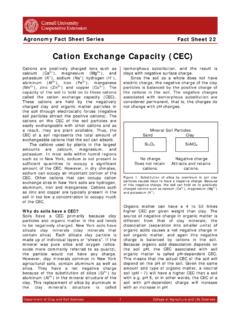Transcription of What Can We Learn From CEC and Base Saturation?
1 What Can We Learn From CEC and base saturation ? George Rehm 507-263-9127 What Is Cation exchange capacity ? In fundamental terms, this permanent soil property is a measure of the relative number of negative electrical charges in soils; reported as milliequivalents per 100 grams of soil ( ) (cmole/100 grams) Two Sources of Electrical Charges clays; CEC increases as % clay increases soil organic matter; not proportional to % soil organic matter AGVISE Gypsum project-Soil 1: Gypsum Rate CaSO4 pH salt Ca ppm Mg ppm K ppm Na ppm 0 lb/a .24 2460 390 551 20 300 lb/a .32 2570 400 573 20 6000 lb/a.
2 92 3040 390 557 20 18000 lb/a 4290 400 563 25 36000 lb/a 6000 440 550 20 Salt level increasing due to gypsum addition. Salt level will increase each year gypsum is added if drainage is poor. Increasing calcium ppm level due to dissolved calcium from the gypsum in the soil Solution being included in the test value. The soil is not actually holding more calcium. Routine ammonium acetate method used to determine Ca, Mg, K, Na AGVISE Gypsum project-Soil 1: Gypsum Rate %Ca %Mg %K % Na CEC 0 72% 19% 8% 17 300 lb/a 72% 19% 8% 18 6000 lb/a 76% 16% 7% 20 18000 lb/a 81% 13% 5% 26 36000 lb/a 86% 10% 4% 35 The % calcium increases due to the dissolved calcium in the soil solution from the gypsum being included in the soil test value.
3 The percentage of the other cations go down as the total of all the cations increases. The soil is not actually holding more calcium. The true CEC of this soil is 18, based on a testing method which does not Include calcium from salts already in the soil or in the gypsum applied. Routine ammonium acetate method used to determine Ca, Mg, K, Na CEC and Soil Texture Soil Texture CEC ( gm.) clay loam 20-30+ silt loam 15-20 loam 12-15 sandy loam 10-12 loamy fine sand less than 10 In Soils exchangeable Bases: Na+, K+, Ca++.and Mg++ other positively charged cations: NH4,+ H+ base saturation = sum of Na+, K+, Ca++, and Mg++ divided by CEC Na+ concentration divided by CEC = % saturated with Na+ could be important in predicting severity of iron deficiency chlorosis otherwise, knowledge of % base saturation is not important in crop production Calculations if concentration of an exchangeable basic cation is known along with CEC, it is possible to calculate % of exchangeable sites occupied by each basic cation then, some believe that ratios are important Ca.
4 Mg Ratios in Minnesota Soils vary over a wide range very high in western MN; low to high in eastern MN some low organic matter sandy soils require Mg in a fertilizer program the basis for the debate over calcitic and dolomitic limestone Some History initial research conducted by Bear and co-workers in New Jersey using acid coastal plain soils from 1945 to 1947 for ideal soil it was suggested that % of exchange sites occupied should be 65% Ca, 10% Mg, 5% K, and 20% H this converts to ratios of 13:2:1 for Ca, Mg, and K or to 1 for Ca and Mg History (con t) in Missouri, Graham (1959) relaxed the ideal saturation to 65 % to 85 % for Ca, 6 % to 12 % for Mg, and 2% to 5% for K published a bulletin providing a general description of soil testing theory.
5 No data presented to support the suggested saturation Corn Yields in Ohio Relative Yield Corn (75) Corn (76) Ca:Mg ratio 5 Highest Yielding Sites to to 5 Lowest Yielding Sites to to Soybean Yields in Ohio Relative Yield Soybean (77) Soybean (78) Ca:Mg ratio 5 Highest Yielding Sites to to 5 Lowest Yielding Sites to to Ca:Mg Ratio and Alfalfa Yield Silt Loam Soil Ratio Yield ton acre Theresa silt loam is a Wisconsin soil No Yield Difference due to wide range of ratio Ca:Mg Ratio and Alfalfa Yield Loamy Fine Sand Ratio Yield ton Plainfield loamy fine sand is a Wisconsin soil No Yield Difference due to wide range of ratio Ca:Mg and Soybean Yield Lime Source Mg Rate Yield lb.
6 None 0 calcitic 0 calcitic 300 dolomitic 0 dolomitic 300 Lime rate = 3500 lb. ENP /Acre initial pH = Ca:Mg ratio = Ca:Mg and Alfalfa Yield (total) Lime Source* Mg Applied Yield ton calcitic 0 calcitic 300 dolomitic 0 dolomitic 300 Lime rate for both sources was 3500 lb. ENP per acre Ca:Mg Ratio After One Year Rate of ENP, source 1750 3500 5250 0 ----------------------ratio------------- --------- none -- -- -- calcitic -- dolomitic -- initial = ; ENP = lb. Effective Neutralizing Power/acre One Summary of the Concept the values suggested bu Bear, Pierce, and Malcolm (1945), Graham, (1959), and Amacher (1981) all represent a good educated guess regarding satisfactory exchangeable cation ratios in most soils for most crops.
7 The fact is, though, that research has not documented that there is an optimum exchangeable cation ratio for any Dr. Charles State University Can Products Affect CEC? NutrAsyst improves fertilizer efficiency improves soil Cation exchange capacity improves soil and plant moisture retention can be impregnated on dry fertilizer A blend of low molecular weight organic acids Value of CEC and base saturation CEC provides an indication of soil texture base saturation does not affect fertilizer guidelines exchangeable Na may help with the IDC problem Summary CEC is a nearly fixed soil property.
8 Measure once CEC is really a measure of soil texture base saturation related to soil acidity exchangeable Na+ may be important in IDC cation ratios have no impact on crop production Questions, Comments, Concerns? Thank You For Your Attention












